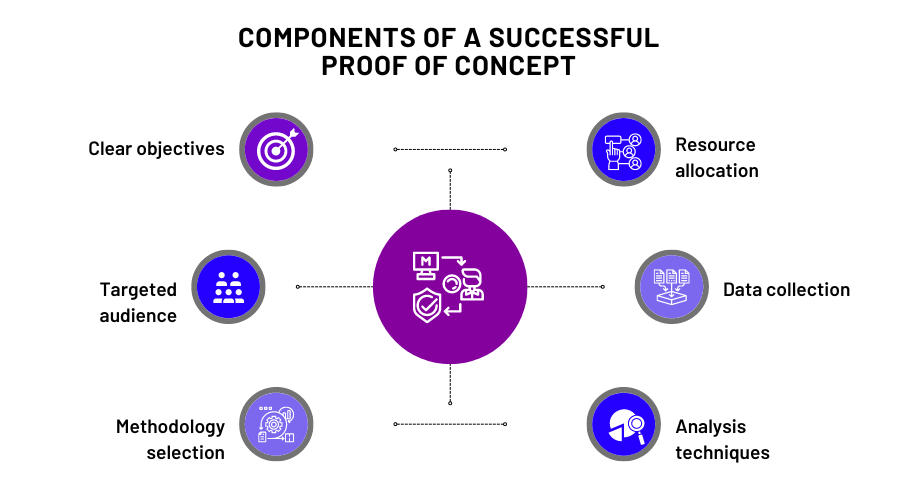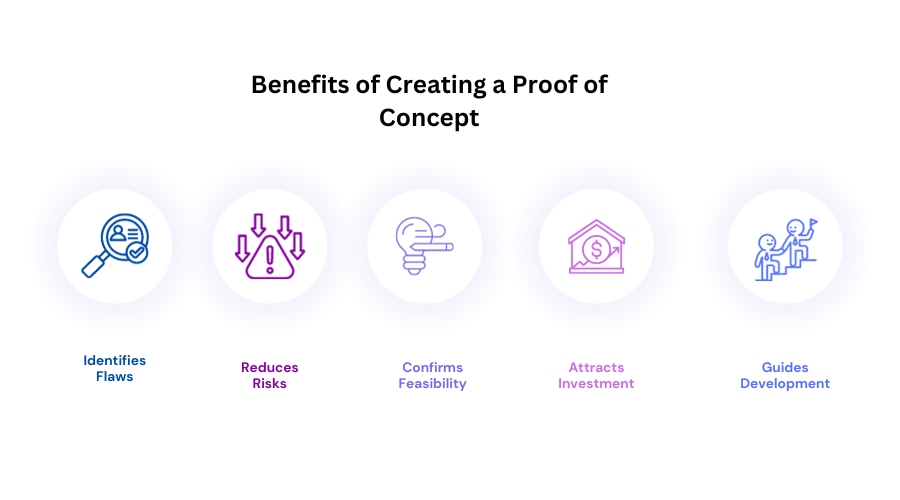
Just like how you would feel disappointed after buying a new phone and realizing it doesn’t meet your requirements, investing in a business venture that doesn’t work out can be equally frustrating. This is where a Proof of Concept (POC) comes into play – it helps you avoid such situations.
A POC can be in various formats but usually involves creating a prototype or a minimum viable product (MVP) to test the viability of your idea. Its main aim is to answer essential questions regarding the feasibility of your product or service and to receive feedback from potential customers. This way, you can make informed decisions and save time, effort, and resources on something that may not work out.
In this article, we’ll cover everything there is to know about proof of concept, from its definition to its practical uses and more. Get set to step up your investment strategy!
What Is Proof of Concept?
Definition of Proof of Concept:
Proof of concept (POC) is used to validate whether an idea or theory could work in the real world business scenarios. It’s like a test run to see if a project or product is worth investing time and resources into. Essentially, a POC is an evidence that something is doable and worthwhile enough to move forward with.
Have you ever had an excellent concept for a brand-new product or service but felt hesitant to spend your time and money on it without first ensuring that it would work?
You don’t have to worry anymore, thanks to Proof of Concept (POC.)
A proof of concept is a prototype or early-stage demonstration confirming whether an idea or technology can deliver the desired outcome. It’s an essential step in the product development process that helps lower the risk of failure for new products and services.
You can use POC to test technical feasibility, assess market demand, and gather feedback from potential users. For example, suppose you have an idea for a new app that you believe has tremendous potential.
Before jumping into full-scale development, you could create a basic version of the app and release it to a small group of users to see if they find it useful. If the app is thriving, you can proceed with development. If you need help, you can save time and money by pivoting or scrapping the project.
Proof of concept is critical in many sectors and fields, including application development, commercial development, project management, manufacturing, IT, healthcare, and cybersecurity. By gathering user feedback and insights from various team members, POCs help mitigate unforeseen risks and increase the likelihood of a successful product launch.
How to Create a Proof of Concept?
We have some good idea about the proof of concept meaning and also its example. Now you might be wondering “How do I create a successful proof concept?” Don’t worry, we got you covered. Here are the proof of concept steps.
- Determine the Necessity of the Product or Service
- Collaborative Ideation for Pain-Points of Target Customers
- Develop a Problem Hypothesis and Propose Solutions
- Prototype Creation
- Refine Through Feedback
- Time to Unveil Your Proof of Concept and Put It to the Ultimate Test
1. Determine the Necessity of the Product or Service
When creating a proof of concept, understanding the product or service’s necessity is crucial. More than simply assuming customer pain points is necessary for successful market research.
Project managers should conduct interviews with a sample of customers, inquire about complaints, and ask about desired user experiences.
Additional research strategies include surveys and secondary research, but it’s important not to ask leading questions.
Video recording and having a team member observe in real-time can be helpful. At the same time, online surveys can speed up the process. Combining these strategies can provide the most valuable data points for businesses to work upon.
2. Collaborative Ideation for Pain-Points of Target Customers
Collaborating with the team and developing viable solutions is essential based on the sample group’s responses. You have to do this to address the pain points of target customers.
Design thinking can be a helpful strategy, but avoiding common mistakes is essential.
The team should evaluate each brainstormed option, considering costs, technology, operations, competition, and resources. The most feasible ideas can get selected to create the final product.
To strengthen the proposal, the team should also discuss how the solution can help achieve organizational or stakeholder objectives.
3. Develop a Problem Hypothesis and Propose Solutions
When launching a new product, it’s essential to have a clear hypothesis of the problem you are trying to solve and how your solution will address it. Let’s say you’re creating a new meal delivery service for busy professionals.
Your hypothesis could be that there is a significant demand for healthy and convenient meal options you can deliver directly to consumers’ homes or workplaces.
You might hypothesize that many professionals need help finding the time to plan and prepare meals that meet their dietary needs and preferences.
To test this hypothesis, you could conduct surveys or focus groups with busy professionals. The aim here is to gather feedback on their current meal habits and pain points.
Based on this feedback, you could refine your hypothesis and develop a solution that meets their needs.
Your solution might include a variety of healthy meal options that can get customized to each customer’s dietary preferences and restrictions.
You could also offer flexible delivery options, such as weekly or monthly subscriptions, to accommodate different schedules and lifestyles.
4. Prototype Creation
Once you’ve researched and brainstormed solutions, it’s time to create a prototype that addresses your target audience’s pain points.
The prototype should reflect the requirements, features, and solutions you identified during the research.
Testing the prototype with the same group throughout the testing phase is essential to document feedback accurately. However, running simulations with different samples is possible if you tally the final results. Incorporating feedback will refine the solution in preparation for the final launch stage.
5. Refine Through Feedback
Collecting and documenting feedback during prototype testing is crucial for improving your proof of concept.
Feedback from the sample group about their experience and reactions provide valuable insight into the solution’s feasibility and usability. Their thoughts on the user interface can also be helpful.
A cloud-based platform is ideal for gathering feedback, allowing easy collaboration and participation from the project team and sample group. It’s important to iterate and improves upon the product and, if necessary, pivot in a different direction based on the data and feedback received.
6. Time to Unveil Your Proof of Concept and Put It to the Ultimate Test
After testing and improving the proof of concept based on feedback, it’s time to showcase it to stakeholders for further testing and approval. In the presentation, highlight the product’s value by outlining the pain points it addresses, its features, and the technologies it incorporates.
Additionally, you should provide details on the product development and project management components, including success criteria, evaluation measures, timelines, following project management plans (if approved), resource requirements, and other factors. Once approved and funded, you can implement the proof of concept.

When Should You Create a POC?
Proof of concept is a great idea when you are coming up with a new product, feature, or project. Here are a few scenarios where POC comes in handy:
- For novel product or methodology development: If proposing an idea that breaks new ground, a proof of concept pilot can help substantiate whether the concept is workable when applied in real-world conditions. When no comparable use cases exist for benchmarking, testing ideas in a proof-of-concept format is prudent.
- For expanding existing project scope: Introducing a new feature or capability to an established project essentially creates something novel. Suppose the added element constitutes an original contribution. In that case, a proof of concept ensures functionality and synergies are maintained once integrated.
Suppose some similar products or services have already been successful. In that case, you may not need to create a proof of concept to prove your idea is feasible. Instead, you can do thorough market research to learn about the performance metrics and adoption patterns of those similar offerings. It will help you to determine if there is a market for your idea and how you can make it successful.
Common Mistakes to Avoid When Creating a POC
Inadequate planning: Rushing into POC without a foolproof plan is a recipe for disaster. You will end up wasting resources and time. Create a detailed project plan, including timelines, milestones, and resource allocation.
- Overly ambitious scope: It can be very burdensome and distracting to try to prove too much in a single PoC. Limit the scope and concentrate on one particular facet of your idea.
- Skipping user feedback: Unless you prioritize user feedback, you will not be able to create a product that meets their needs. You should never neglect to gather feedback from potential users or stakeholders.
- Neglecting scalability: When transitioning to a full-scale implementation, problems can occur if the only emphasis is on proving the concept rather than considering scalability. Evaluate the possibility for expansion and sustainability.
- Rushing to implementation: Making hasty decisions and mistakes might result from assuming that the success of a proof of concept ensures its fast deployment. Analyze the results attentively while considering future improvements.
By avoiding these common blunders, you may increase the likelihood of a successful proof of concept and set the stage for a smooth transition into a bigger endeavor or product.
Key Highlights:
- Primary purpose of a proof of concept is to validate the technical and economic feasibility of a solution or innovation before committing to full-scale development.
- By focusing on limited scope, the proof of concept help identify potential risks, issues, or limitations early in the development process.
- A proof of concept allow organizations to assess the potential return on investment and make adjustments or pivots if the results are not as expected.
- Successful POCs provide evidence and data that can guide decision-makers in determining whether to proceed with a project, allocate resources, and secure funding.
What Are Some Real Life Proof of Concept Examples?
Below are examples of proof of concept from various companies:
Dropbox
One of the best proof of concept example is Dropbox. The company created a viral explainer video of its software’s potential features, which led to an overnight increase in its beta sign-up list. The footage helped Dropbox validate its idea and build an audience of future customers before the product’s launch.
SwipeWell
SwipeWell built an email list of potential customers before launching its product, demonstrating the importance of creating demand and validating an idea before investing in a product. Other companies like AngelList used blogs to stir up interest and acquire their first customers.
Drip
Drip’s founder conducted interviews within his network to asses how much people would be willing to pay for his email marketing engine. This method validated the proposed idea and highlighted the importance of keeping the PoC phase high-level.
Allbirds
Allbirds is another top notch proof of concept example. Allbirds and Pebble launched crowdfunding campaigns to test consumer interest and whether people are willing to pre-pay for a product. This proof of concept validates an idea while raising capital to fund the product’s development.
Buffer
Buffer and other companies built landing pages to assess demand and establish themselves in the market. This type of proof of concept is a great way to test an idea’s viability and build a foundation for SEO-driven content.
Etsy
Etsy observed what was already working in the market and based its product on that. This proof of concept helps companies to leverage the success of others and save time and resources in product development.
What Should Be Included in a Proof of Concept?
When you, as a business, set out to create a proof of concept (PoC), there are several crucial elements that you need to consider.
Although the specifics of proof of concept may vary depending on the type of your business, certain key aspects should always get included.
A proof of concept should include the following elements:
- Problem statement: Clearly define the problem or challenge the proof of concept aims to address.
- Objectives: Outline the specific goals and outcomes the proof of concept seeks to achieve.
- Hypothesis: Formulate a hypothesis or proposed solution to test during the proof of concept.
- Methodology: Describe the approach, techniques, tools, and resources used to prove the concept.
- Data collection: Specify the data points and metrics that will be collected to evaluate the success of the proof of concept.
- Analysis and findings: Present the results of the proof of concept, including insights, observations, and conclusions drawn from the data collected.
- Recommendations: Provide recommendations based on the proof of concept findings, such as next steps, adjustments, or further development required.
- Limitations and assumptions: Identify any limits, constraints, or assumptions made during the proof of concept process.
What Are the Benefits of Creating a Proof of Concept?
It’s important to note that a brilliant concept doesn’t guarantee instant success. In reality, nearly 90% of new startups fail to take flight, and a staggering 95% of new products encounter difficulties in finding a market, ultimately leading to their downfall. That is why a proof of concept is super essential
We’ll discuss some of the most compelling benefits of proof of concept.

Validates Your Idea Cheaply and Quickly
Developing an idea into an operating product can be a risky move that might result in a loss of resources. With a proof of concept, you can test your ideas quickly and cheaply, ensuring demand for the product and the feasibility of developing it.
Builds Confidence With Interested Parties
Investors and other stakeholders appreciate proof of concept because of the valuable data they generate. A POC can assist product development teams in demonstrating a product’s benefits to investors and increase their confidence in investing in it.
Mitigates Risk and Predicts Possible Problems
Evaluating a POC before product development enables companies to foresee potential risks and identify practical limitations of a project. It helps manage research and development resources efficiently and brainstorm solutions to possible problems before the production phase.
Reasonably Priced and Flexible
Proofs of Concepts are an efficient and effective way of testing product ideas before committing to a full-scale production. It enables business leaders to build an iterative, customizable, and easily adaptable prototype that can get modified as discoveries and feedback are received. It allows businesses to save time and money by pre-planning and verifying technical assumptions and use cases before further investing in additional labor, resources, or extra costs.
Great Accessibility
Having a Proof of Concept (POC) environment is critical to the success of any business. It allows stakeholders to trial and test new ideas and concepts with real data and to get feedback quickly. Thanks to cloud-hosted POC environments, users can now access and update these environments from practically anywhere at any time.
It allows teams to work more quickly and efficiently, no matter where they get located. It also ensures that everyone can access the same software version so that any problems or bugs can be quickly located and fixed. The resulting feedback is invaluable when bringing new products and services to market. Ultimately, having a cloud-hosted POC environment has made it easier for businesses to take their ideas from concept to reality.
More like this:
- What is Rapid Prototyping? [Definition and Examples]
- What is Ideation? Definition, Meaning and Process
- What Is a Beta Test? Definition and Overview
- What Is an Alpha Test? Definition and Overview
- What Is Stakeholder Management? Definition & Principles
- What Is Stakeholder Management Plan? Definition & Create
- Top 9 Tips To Make Your Life Simpler With Stakeholders
FAQs
A proof of concept (PoC) is a way of testing the waters before diving headfirst into a new project. The aim is to see whether the project is feasible and whether the overall idea is viable. From a software development perspective, a PoC is to demonstrate that the product idea and business plan can work in practice.
A successful proof of concept is a document or presentation that effectively showcases the idea, identifies the intended audience, and outlines the necessary steps to bring the vision to life. It’s a way to introduce people to a new concept and demonstrate its potential value clearly and concisely. A well-crafted proof of concept can help garner interest and support for the idea, making it more likely to succeed.
Alternative terms for “proof of concept” can be:
- Proof of principle
- Prototype
- Concept validation
- Feasibility study
